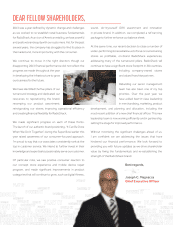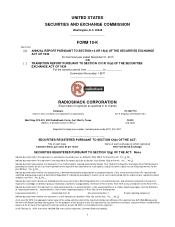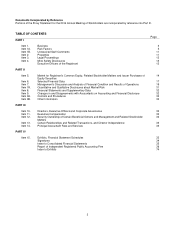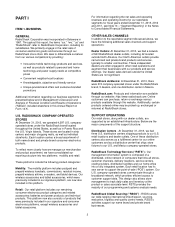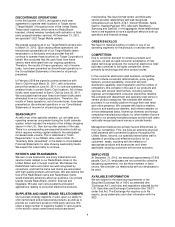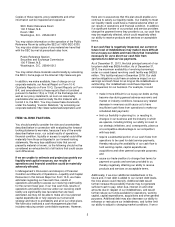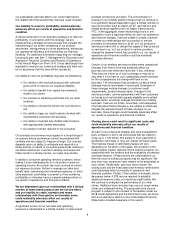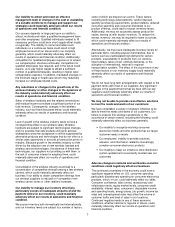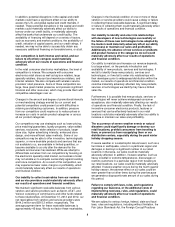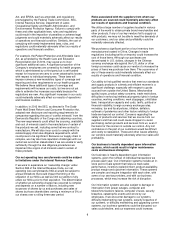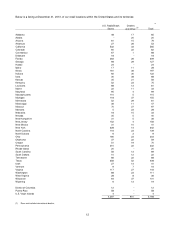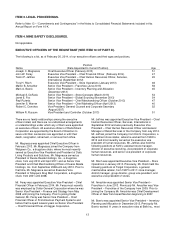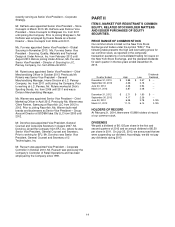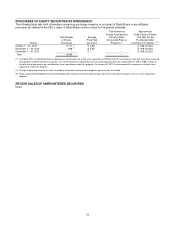Radio Shack 2013 Annual Report Download - page 7
Download and view the complete annual report
Please find page 7 of the 2013 Radio Shack annual report below. You can navigate through the pages in the report by either clicking on the pages listed below, or by using the keyword search tool below to find specific information within the annual report.
5
Copies of these reports, proxy statements and other
information can be inspected and copied at:
SEC Public Reference Room
100 F Street, N.E.
Room 1580
Washington, D.C. 20549-0213
You may obtain information on the operation of the Public
Reference Room by calling the SEC at 1-800-SEC-0330.
You may also obtain copies of any material we have filed
with the SEC by mail at prescribed rates from:
Public Reference Section
Securities and Exchange Commission
100 F Street, N.E.
Washington, D.C. 20549-0213
You may obtain these materials electronically by accessing
the SEC’s home page on the Internet: http://www.sec.gov
In addition, we make available, free of charge on our
corporate website, our Annual Report on Form 10-K,
Quarterly Reports on Form 10-Q, Current Reports on Form
8-K, and amendments to these reports filed or furnished
pursuant to Section 13(a) or 15(d) of the Exchange Act, as
well as our proxy statements, as soon as reasonably
practicable after we electronically file this material with, or
furnish it to, the SEC. You may review these documents,
under the heading “Investor Relations,” by accessing our
corporate website: http://www.radioshackcorporation.com
ITEM 1A. RISK FACTORS.
You should carefully consider the risks and uncertainties
described below in connection with evaluating the forward-
looking statements we make, because if any of the events
described below occur, our actual results of operations,
financial condition, liquidity or access to capital could differ
materially from those anticipated in our forward-looking
statements. We may face additional risks that are not
presently material or known, so the following should not be
considered an exhaustive list of all factors that could cause
such differences.
If we are unable to estimate and project accurately our
liquidity and capital resources, our results of
operations and financial condition could be materially
adversely affected.
In Management’s Discussion and Analysis of Financial
Condition and Results of Operations—Liquidity and Capital
Resources in this Annual Report on Form 10-K, we make
estimates regarding our free cash flow, results of
operations and ability to access our revolving credit facility
for the current fiscal year. If our free cash flow, results of
operations and ability to borrow under our revolving credit
facility are significantly less favorable than we have
estimated, we may not be able to make all of our planned
capital expenditures or fully execute our turnaround
strategy and return to profitability and all of our other plans.
We have also instituted a cash management plan that
includes reducing certain controllable expenses. However,
there are no assurances that this plan would enable us to
continue to satisfy our liquidity needs. Our inability to meet
our liquidity needs could have a material adverse effect on
our results of operations and financial condition. In addition,
if a significant number of our product and service providers
change the payment terms they provide to us, our cash flow
may be negatively affected, which could negatively affect
our ability to receive products and services on acceptable
terms.
If our cash flow is negatively impacted, our current or
future level of indebtedness may make it more difficult
for us to pay our debts and more likely that it would be
necessary for us to divert our cash flow from
operations to debt service payments.
As of December 31, 2013, the total principal amount of our
long-term debt was $626.4 million. As of December 31,
2013, the maximum availability of revolving borrowings
under our asset-based revolving credit facility was $429.5
million. This facility matures in December 2018. Our debt
service obligations could have an adverse impact on our
earnings and cash flows for as long as the indebtedness is
outstanding. Our indebtedness could have important
consequences for our business. For example, it could:
• make it more difficult for us to pay our debts as they
become due during general adverse economic and
market or industry conditions, because any related
decrease in revenues could cause us to have
insufficient cash flows from operations to make our
scheduled debt payments;
• limit our flexibility in planning for, or reacting to,
changes in our business and the industry in which
we operate, including limiting our ability to invest in
our strategic initiatives, and, consequently, place us
at a competitive disadvantage to our competitors
with less debt;
• require a substantial portion of our cash flows from
operations to be used for debt service payments,
thereby reducing the availability of our cash flow to
fund working capital, capital expenditures,
acquisitions and other general corporate purposes;
and
• cause our trade creditors to change their terms for
payment on goods and services provided to us,
thereby negatively affecting our ability to receive
products and services on acceptable terms.
Additionally, if we incur additional indebtedness in the
future and, if new debt is added to our current debt levels,
the risks above could intensify. Additional debt would
further increase the possibility that we may not generate
sufficient cash to pay, when due, interest on and other
amounts due in respect of our indebtedness, and would
further reduce our funds available for operations, working
capital, capital expenditures, acquisitions and other general
purposes. Additional debt may also decrease our ability to
refinance or restructure our indebtedness, and further limit
our ability to adjust to changing market conditions. If we or


